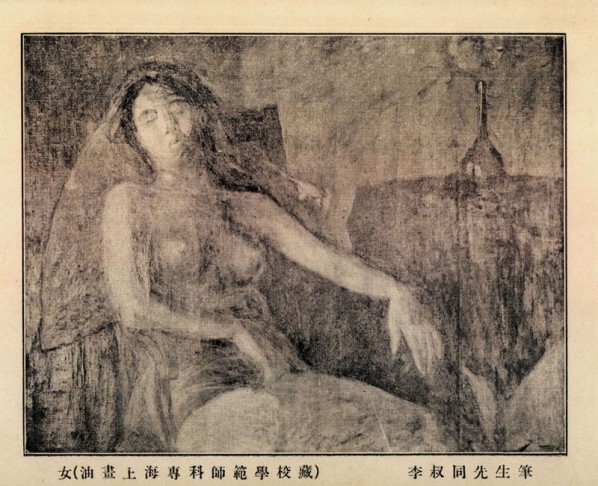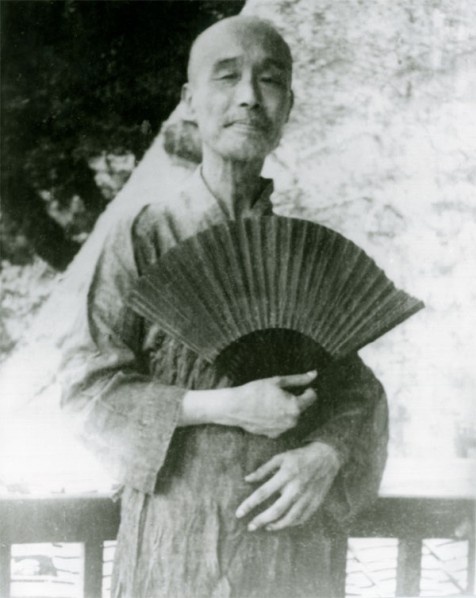
Comparisons between A Half-naked Woman collected in CAFA Art Museum and Historical Publications of Li Shutong's Masterpiece with the same title
In the afternoon of March 27th, 2012, CAFA Art Museum convened a meeting of experts on the “Identification and Seminar of Li Shutong’s A Half-naked Woman” and Shao Dazhen, Zhong Han, Lang Shaojun, Li Shusheng, Tao Yongbai, Liu Xilin, Shang Jinlin, Yin Jinan, Yi Shuangxi, Zhu Qingsheng, Zheng Gong, Li Weiming, Liu Xin, Li Chao, Chen Xing, Zhao Li, Cao Qinghui and Ye Yonghe were present. At the meeting, Prof. Wang Huangsheng, Curator of CAFA Art Museum announced the details of this discovery as well as the results of related research on Li Shutong’s A Half-naked Woman. At the same time, he put forward some questions that needed to be further clarified for experts and scholars from whom he received a partisan as well as a professional perspective.

Li Shutong, A Half-naked Woman; Oil on Canvas, 91x116.5cm(collected in CAFA Art Museum)

A Half-naked Woman(collected in CAFA Art Museum) contrasted with the version with lines made by folding

A Woman(oil painting collected by Shanghai Normal School), Aesthetic Education 01 issued by China Aesthetic Association on April 20th, 1920
In the second half of 2011, CAFA Art Museum sorted out the serious and in-depth collections created during the period of the Republic of China and confirmed lots of important works by Li Yishi, Wu Fading, Zhang Anzhi, Sun Zhongwei and other masters of China, some of which are large in size and belong to their collection of masterpieces. However, the most significant finding is this “A Half-naked Woman” by Li Shutong (oil painting). It ranks among the major events in the cultural history and art history of China and it is significant for research on Li Shutong and Chinese oil painting origins.
Hong Yi (1880–1942) (Chinese: 弘一大師 Hóngyī Dashi), born Li Shutong (李叔同) was a Chinese Buddhist monk, artist and art teacher. He also went by the names of Wen Tao, Guang Hou, and Shu Tong, but was most commonly known by his Buddhist name, Hong Yi. He was a master painter, musician, dramatist, calligrapher, seal cutter, poet, and Buddhist monk.

Li Shutong
Li Shutong was born in Tianjin to a banking family originating in Hongdong County, Shanxi, that migrated to Tianjin during the Ming Dynasty, though his mother was from Pinghu, Zhejiang province. In 1898 Li moved to Shanghai and joined the "Shanghai Painting and Calligraphy Association", and the "Shanghai Scholarly Society" while he was attending the Nanyang public school. In 1905 Li went to Japan to study at Tokyo School of Fine Art in Ueno Park where he specialized in Western painting and music, and met a lover by the name of Yukiko who was to become his concubine. In 1910 Li returned to China and was appointed to Tianjin's Beiyang Advanced Industry School. The next year he was appointed as a music teacher in a girl's school in Shanghai. He went to Hangzhou in 1912 and became a lecturer in the Zhejiang Secondary Normal College. He taught not only Western painting and music but also art history. By 1915 Jiang Qian hired him as a teacher at Nanjing Normal College (renamed in 1949 to Nanjing University), where he taught painting and music. He also taught at Zhejiang Secondary Normal School, the predecessor to the famous Hangzhou High School.
During these later years, Li’s reputation grew, as he became the first Chinese educator to use nude models in his painting classes, not to mention the first teacher of Western music in China. Li Shutong himself was also an accomplished composer and lyricist. Many of his compositions are still remembered and performed today. In 1916, Li underwent a 21-day fast at a temple in Hangzhou, and experienced the benefits of a spiritual life. The following year, he took refuge in the Three Jewels of Buddhism. After spending another year there, Li began a new chapter in his life by choosing to be ordained as a monk, and thus began a holistic life dedicated to propagating Buddhism and its code of conduct. After becoming a monk he practiced only calligraphy, developing a simple and unadorned, yet unique style, which was treasured by everyone who received a sample. He became known to all as Master Hong Yi. In 1942, Master Hong Yi died peacefully at the age of 63 in Quanzhou, Fujian Province. A special 130th anniversary celebration of Master Hong Yi showcasing his calligraphy and painting works took place in 2010 in Shanghai, partly sponsored by the Pinghu Municipal Government, and attended by a granddaughter of Hong Yi.




























